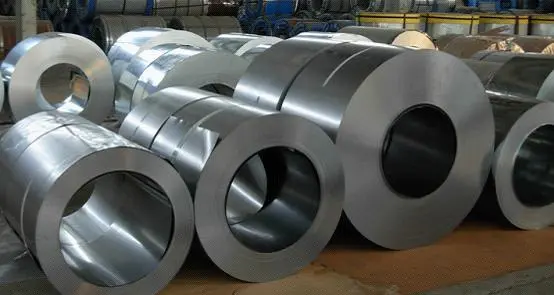Understand industrial cold-rolled steel plates
Introduction to ordinary cold-rolled sheet metal
It is a product obtained by cold pressure processing of hot-rolled thin plates. Due to multiple cold rolling processes, its surface quality is superior to that of hot-rolled thin plates, and after heat treatment, good mechanical properties can be obtained.

1. Classification of uses of ordinary cold-rolled sheet metal
According to the different needs of production enterprises, cold-rolled plates are usually divided into:
Generally used are cold-rolled sheets, stamping grade cold-rolled sheets, deep drawn, extra deep drawn, and ultra deep drawn cold-rolled sheets,
Generally delivered in rolls and plates, with thickness expressed in millimeters,
The width is generally 1000mm and 1250mm, and the length is generally 2000mm and 2500mm.
2. Grade of ordinary cold-rolled sheet metal
The commonly used grades are:
Q195、Q215、Q235、08AL、SPCC、SPCD、SPCE、SPCEN、ST12、ST13、ST14、ST15、ST16、DC01、DC03、DC04、DC05、DC06 Wait;
ST12:Expressed as the most common Steel grade, with materials similar to Q195, SPCC, and DC01 grades;
ST13/14:The steel grade represented as stamping grade is basically the same as the material of 08AL, SPCD, DC03/04 grades;
ST15/16:The steel grade represented as stamping grade is basically the same as the material of 08AL, SPCE, SPCEN, DC05/06 grades.
3. Method for representing the grade and size of ordinary cold-rolled sheet metal
For example, ST12, 1 * 1250 * 2500/C, is represented as: Grade ST12 ordinary cold plate, thickness of 1mm, width of 1250mm, length of 2500mm or C coil material.
The appearance is made of white iron leather with precision packaging, and the mechanical properties are the most ordinary and basiC Steel grade. It can only be used for bending and cannot be used for stamping. Used for mechanical biting,
For example, the outer shell of a refrigerator, the fuel tank of a vehicle, etc.
ST13 and above products are used in industries that require deep drawing, such as automobile manufacturing, diesel engine fuel tanks, etc. The specific type to be used depends on its deep drawing requirements.
The difference between ST12 and SPCC: The mechanical properties of the two products are almost the same, only the annealing method is different. The tensile properties of ST12 material products are relatively stronger than SPCC.
4.Meaning of Japanese JIS standard materials
SPCC -- S stands for Steel, P stands for Plate, C stands for Cold, and C stands for Commercial, according to the Japanese JIS standard.
To ensure tensile strength, add T at the end of the grade, which is SPCCT.
SPCD - stands for cold-rolled carbon Steel Sheets and strips for stamping, equivalent to China's 08AL (13237) high-quality carbon structural steel.
SPCE stands for cold-rolled carbon steel sheets and strips for deep drawing, equivalent to China's 08AL (5213) deep drawing steel.
To ensure non timeliness, add N to SPCEN at the end of the grade.
Cold rolled carbon steel sheet and strip quenching and tempering code: annealed state is A, standard quenching and tempering is S, 1/8 hardness is 8, 1/4 hardness is 4, 1/2 hardness is 2, and full hardness is 1. Surface processing code: matte precision rolling is D, bright precision rolling is B.
For example, SPCC-SD stands for standard quenched and tempered, matte finish rolled carbon thin sheets commonly used.
For example, SPCCT-SB stands for cold-rolled carbon thin plates that require standard tempering and bright processing to ensure mechanical properties.
For example, SPCC-1D stands for hard, matte finish cold-rolled carbon steel sheet.
The representation method of steel grades for mechanical structures is: S+carbon content+letter codes (C, CK), where carbon content is represented by the median * 100, letter C represents carbon, and letter K represents carburizing steel. The carbon content of carbon rolled plate S20C is 0.18-0.23%.
5.Meaning of Chinese GB standard materials
Basically divided into:
Q195, Q215, Q235, Q255, Q275, etc.
Q represents the first letter of the Chinese Pinyin for the yield point of steel, and 195, 215, etc. represent the numerical values of the yield point,
From a chemical composition perspective, low carbon steel grades:
The larger the grades Q195, Q215, Q235, Q255, and Q275, the higher the carbon and manganese content, and the more stable their plasticity.
6、 Introduction to hot-dip galvanized steel sheet (silver white)
It is produced using hot-rolled steel strip or cold-rolled steel strip as the substrate through continuous hot-dip galvanizing process, which can prevent corrosion and rust on the surface of thin steel sheet and steel strip.
The hot-dip galvanized sheet is supplied as a rectangular flat plate through cross cutting; Hot dip galvanized coils are supplied in the form of rolls.
Due to the different substrates used, hot-dip galvanized steel sheets can be divided into hot-rolled galvanized sheet coils and cold-rolled hot-dip galvanized sheet coils, which are mainly used in fields such as construction, home appliances, automobiles, containers, transportation, and home industry. Especially in industries such as steel structure construction, automobile manufacturing, and steel plate window manufacturing.
7. Characteristics of hot-dip galvanized steel sheet
Strong corrosion resistance, good surface quality, conducive to deep processing, economical and practical, etc.
8. Classification and symbols of hot-dip galvanized steel plates
Divided by processing performance: general purpose (PT), mechanical bite (JY), deep drawing (SC), ultra deep drawing aging (CS), structural (JG);
According to the weight of the zinc layer, pure zinc surface is divided into: 100/100 (zinc layer weight less than 100g/m2)
120/120, 200/200, 275/275, 350/350, 450/450, 600/600;
The surface of zinc iron alloy is divided into: 90/90
(Zinc iron alloy layer weight less than 90g/m2), 100/100, 120/120, 180/180;
Divided by surface structure: normal zinc flower Z, small zinc flower X, polished zinc flower GZ, zinc iron alloy XT;
Divided by surface quality: Group I (I), Group II (II);
Divided by dimensional accuracy: advanced accuracy A, ordinary accuracy B;
According to surface treatment, it can be divided into: chromic acid passivation L, oil coating Y, and chromic acid passivation plus oil coating LY.















